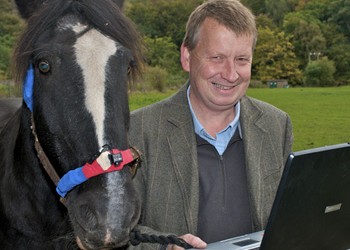RESEARCHERS have adopted ‘Big Brother’ tactics to tackle growing levels of obesity in Britain’s horse population.
Begins a spokesperson: “One in three horses, and over 80 per cent of ponies, are currently believed to be in danger of fat-related health risks such as laminitis – the equine equivalent of a human heart attack.
“Now, a pioneering scientific study is set to put different breeds under 24-hour surveillance to find out what makes some fillies ‘fitties’ or ‘fatties’.
“Tiny cameras, GPS devices and movement monitors will be attached to the animals in order to analyse every last aspect of their lifestyles.”
A research team from Edinburgh Napier University and horse feed manufacturer Dodson & Horrell have teamed up to run the three-year project.
“The equipment will allow us to distinguish between food-related effort and other exercise – the horse equivalent of a trip to the fridge or the gym,” said study leader, Dr Dave Smith, a veterinary nursing lecturer at Edinburgh Napier University.
The research, which is the first of its kind, will be conducted at a Norfolk farm run by charity, World Horse Welfare. Around 15 horses will initially graze in paddocks specially seeded with different grasses by retailer, Oliver Seeds.
Dr Smith said: “We suspect a major factor in rising obesity levels has been the move from grazing in traditional meadows, which naturally feature a variety of grasses, to monoculture fields more suited to dairy cows.
“However, there are also horse and pony owners who, through overfeeding, are unwittingly killing with kindness. Even horses in ‘show’ condition can be significantly overweight.”
Dr Teresa Hollands, senior nutritionist at Dodson & Horrell, said a prior study had shown that obese horses were at greater risk of developing skin, muscular and bone problems, as well as laminitis – a life-threatening inflammation of the hoof.
“Owners forget that although they might not be putting food in a bucket, these ponies and horses are over-consuming calories from grass,” she said.
“What’s interesting is that some animals that graze together in the same field get fat, while others remain perfectly healthy. What we hope to find out with this study is if there is a horse equivalent of the human couch potato.”
Every chew and canter will be followed online by researchers via webcams attached to each horse.
“We will be watching them around the clock as they go about their natural routines,” said Dr Hollands.
“It will allow us to find out who the grazers or gorgers are, exactly how far they travel, how much they eat, and what they eat.
“Once we have that data for each breed we will then be able to advise owners on how best to feed and manage their horses so they don’t get fat and unhealthy.”
MEDIA RELEASE posted by Edinburgh Napier University. You too can post media releases (aka press releases) on allmediascotland.com. For more information, email here.
Contact: Patrick McFall
Email: p.mcfall@napier.ac.uk
Website: http://www.napier.ac.uk/Pages/home.aspx






